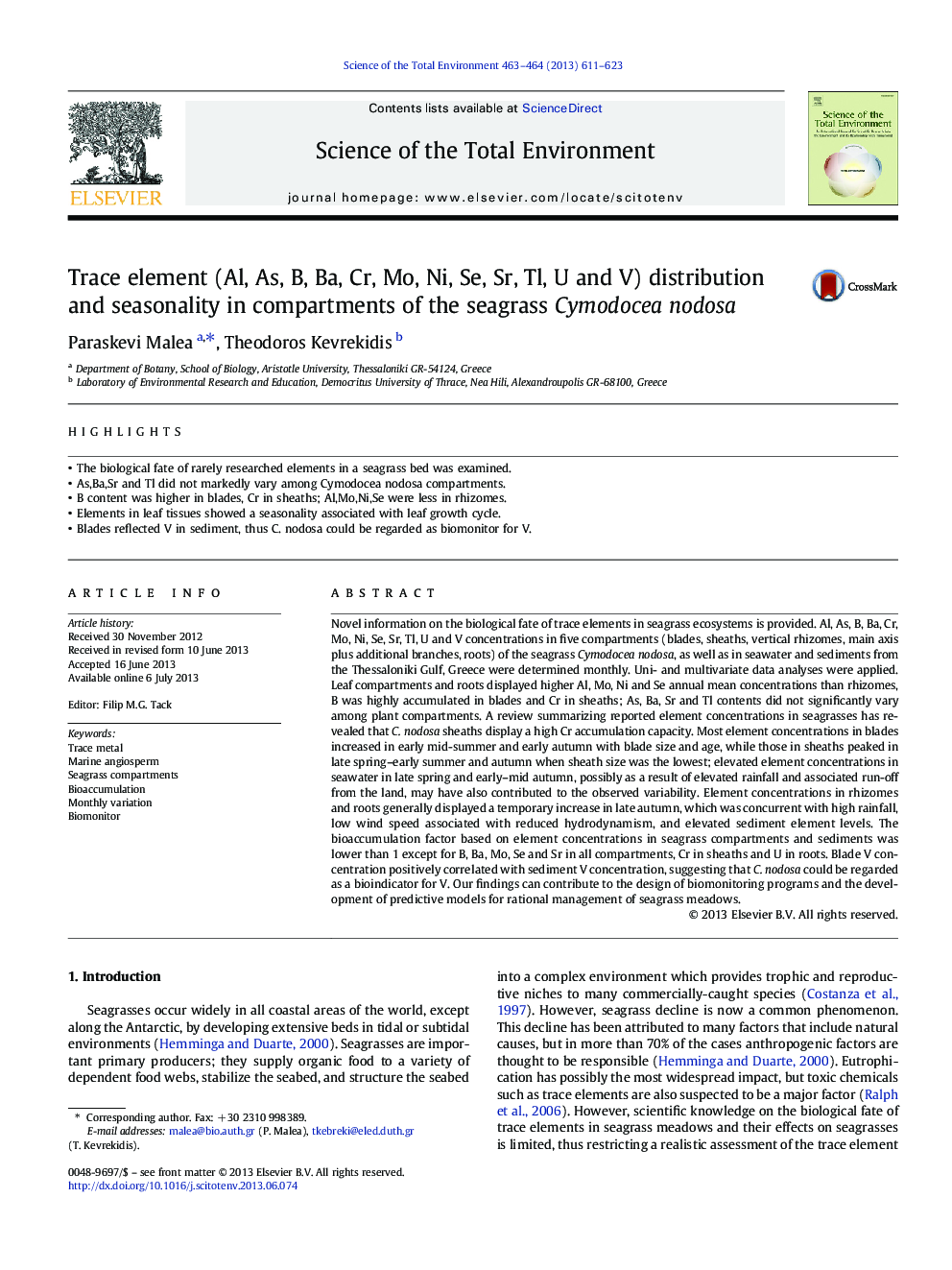| کد مقاله | کد نشریه | سال انتشار | مقاله انگلیسی | نسخه تمام متن |
|---|---|---|---|---|
| 6332859 | 1619798 | 2013 | 13 صفحه PDF | دانلود رایگان |
عنوان انگلیسی مقاله ISI
Trace element (Al, As, B, Ba, Cr, Mo, Ni, Se, Sr, Tl, U and V) distribution and seasonality in compartments of the seagrass Cymodocea nodosa
دانلود مقاله + سفارش ترجمه
دانلود مقاله ISI انگلیسی
رایگان برای ایرانیان
کلمات کلیدی
موضوعات مرتبط
علوم زیستی و بیوفناوری
علوم محیط زیست
شیمی زیست محیطی
پیش نمایش صفحه اول مقاله

چکیده انگلیسی
Novel information on the biological fate of trace elements in seagrass ecosystems is provided. Al, As, B, Ba, Cr, Mo, Ni, Se, Sr, Tl, U and V concentrations in five compartments (blades, sheaths, vertical rhizomes, main axis plus additional branches, roots) of the seagrass Cymodocea nodosa, as well as in seawater and sediments from the Thessaloniki Gulf, Greece were determined monthly. Uni- and multivariate data analyses were applied. Leaf compartments and roots displayed higher Al, Mo, Ni and Se annual mean concentrations than rhizomes, B was highly accumulated in blades and Cr in sheaths; As, Ba, Sr and Tl contents did not significantly vary among plant compartments. A review summarizing reported element concentrations in seagrasses has revealed that C. nodosa sheaths display a high Cr accumulation capacity. Most element concentrations in blades increased in early mid-summer and early autumn with blade size and age, while those in sheaths peaked in late spring-early summer and autumn when sheath size was the lowest; elevated element concentrations in seawater in late spring and early-mid autumn, possibly as a result of elevated rainfall and associated run-off from the land, may have also contributed to the observed variability. Element concentrations in rhizomes and roots generally displayed a temporary increase in late autumn, which was concurrent with high rainfall, low wind speed associated with reduced hydrodynamism, and elevated sediment element levels. The bioaccumulation factor based on element concentrations in seagrass compartments and sediments was lower than 1 except for B, Ba, Mo, Se and Sr in all compartments, Cr in sheaths and U in roots. Blade V concentration positively correlated with sediment V concentration, suggesting that C. nodosa could be regarded as a bioindicator for V. Our findings can contribute to the design of biomonitoring programs and the development of predictive models for rational management of seagrass meadows.
ناشر
Database: Elsevier - ScienceDirect (ساینس دایرکت)
Journal: Science of The Total Environment - Volumes 463â464, 1 October 2013, Pages 611-623
Journal: Science of The Total Environment - Volumes 463â464, 1 October 2013, Pages 611-623
نویسندگان
Paraskevi Malea, Theodoros Kevrekidis,